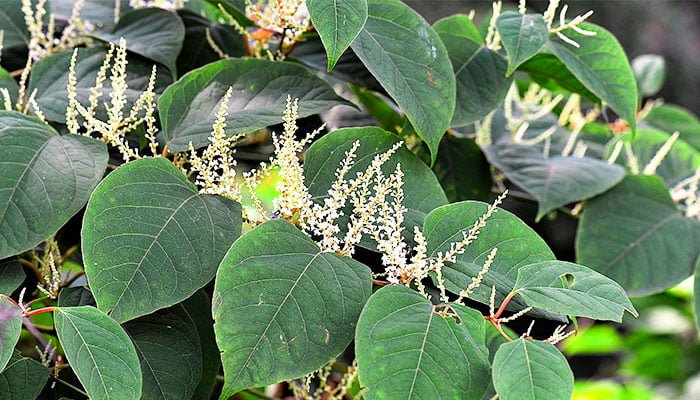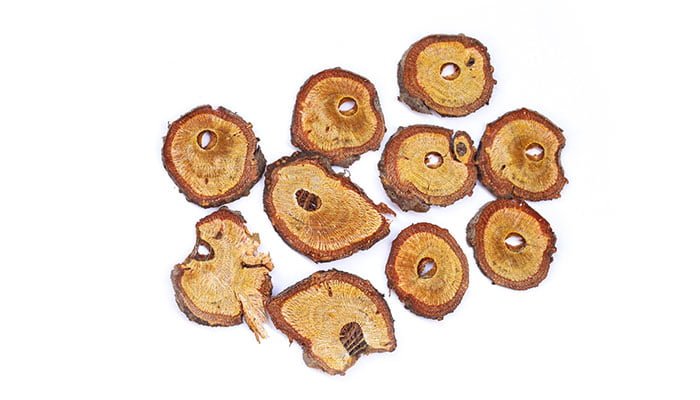What Is Hu Zhang
Hu Zhang commonly known as Polygoni Cuspidati Rhizoma et Radix is the root and rhizome of Polygonum cuspidatum Sieb. et Zucc, which is a perennial herb belonging to the family Polygonaceae. It is a relatively practical and common Chinese herbal medicine, which first appeared in <Mingyi Bie Lu> around 420-589 AD.
Previously, Polygonum cuspidatum Sieb. et Zucc belonged to the genus Polygonum. It is now grouped into the genus Reynoutria. There are about 6 species of Reynoutria, which are widely distributed in East Asia, Europe, and North America.
The synonyms of Polygonum cuspidatum Sieb. et Zucc include Reynoutria japonica Houtt, and Fallopia japonica (Houtt.) Ronse Decr, which is also known as Japanese knotweed and Asian knotweed. This plant prefers warm and humid climates. They are native to Japan, China, and Korea, and have been introduced to North America and Europe. They often grow at altitudes of 140-2,000 meters in hillside thickets, valleys, roadsides, and field wetlands.

In spring and autumn, people gather the roots and rhizomes of Polygonum cuspidatum Sieb. et Zucc, remove their fibrous roots and impurities, wash them with water, cut them into sections or thick slices, dry them in the sun, and make them into Chinese herbal medicines.
Hu Zhang contains anthraglycoside A, anthraglycoside B, chrysophanol-8-O-β-D-glucoside, polyganin A, polyganin B, citreorosein, physcion, emodin, fallacinol, questin, aloe-emodin, questinol, rhein, chrysophanol, xanthorin, isorhodoptilometrin, 2-methoxy-6-acetyl-7-methyljuglone, 7-acetyl-2-methoxy-6-methyl-8-hydroxyl-1, 4-naphthoquinone, cuspidatumin A, cuspidatumin C, phylloquinone B, phylloquinone C, resveratrol, polydatin, piceatannol glucoside, apigenin, quercetin, kaempferol, querectin-3-O-arabinoside, hyperoside, isoquercitrin, reynoutrin, luteolin-7-O-glucoside, catechin, epicatechin, genistein, hesperetin, rutin, caffeic acid, ferulic acid, chlorogenic acid, coumarins, lignans, phenol acids, β-sitosterol, daucosterol, oleanolic acid, acetophenones, fatty acid, and some trace elements.
Generally, the solid Hu Zhang with a brownish-yellow cross-section and light odor is preferred.
According to the Chinese Pharmacopoeia, the medicinal nature of Hu Zhang is slightly cold, with a bitter taste. It has a certain therapeutic effect on the pathological changes of the liver, gallbladder, and lung meridians.
In traditional Chinese medicine, it is often used to drain dampness to relieve jaundice, clear heat and remove toxins, dissipate blood stasis and relieve pain, resolve phlegm and stop cough, and treat jaundice due to damp-heat, turbid stranguria, leukorrhea, carbuncle, pyogenic infection, burns and scalds, cough, amenorrhea, abdominal mass, rheumatoid joint pain, traumatic injury, atherosclerosis, acute bronchitis, chronic bronchitis, chronic cholecystitis, pharyngitis, purulent tonsillitis, pediatric mycoplasma pneumonia, respiratory syncytial virus pneumonia, coronavirus infection, chronic hepatitis, liver cirrhosis, type 2 diabetes, gout, gastric bleeding, fungal vaginitis, endometriosis, chronic pelvic inflammatory disease, hyperinsulinemia, hyperbilirubinemia, hyperlipidemia, psoriasis, and snake bites.
There are more than 200 kinds of traditional Chinese medicine prescriptions containing it, such as Fu Fang Hu Zhang Pian, Re Yan Ning Granules, and Dan Ning Pian.
Benefits
- Anti-virus, inhibiting HIV, hepatitis B virus, herpes simplex virus, zoster virus, pseudorabies influenza and parainfluenza virus, vaccinia virus.
- Anti-inflammation, inhibiting Freund’s complete adjuvant-induced joint swelling and serotonin-induced paw edema in mice [1].
- Increasing the pain threshold and inhibiting the pain caused by the hot plate test and tail-flick test in mice [1].
- Scavenging DPPH free radicals, superoxide anion free radicals, and hydroxyl free radicals, inhibiting lipid peroxidation [2].
- Lowering blood uric acid level and promoting uric acid excretion in hyperuricemia model rats [3].
- Clearing heat and promoting diuresis, and treating jaundice, difficulty and pain in micturition, turbid stranguria, and leukorrhea due to damp-heat.
- Clearing heat and removing toxins, treating carbuncles and sores caused by heat toxins accumulation.
- Treating burns and scalds, pyogenic infection, and snake bites.
- Promoting blood circulation to remove blood stasis, treating amenorrhea, algomenorrhea, and abdominal masses caused by stasis blocking.
- Purging heat and resolving phlegm, treating cough caused by lung-heat.
- In vitro inhibition of Staphylococcus aureus, Enterococcus faecalis, Pseudomonas aeruginosa, Archaea brucei, Archaea cryophila, Streptococcus mutans, and Vibrio vulnificus.
- Resveratrol attenuated oxidative damage and improved learning and memory ability in the Morris water maze test and neuromuscular coordination and sensorimotor capacity in the tightrope test in the brain of senescence-accelerated mice [4].
- Polydatin and resveratrol derived from P. cuspidatum were found to be specific and selective inhibitors for SARS-CoV-2, 3CLpro, and PLpro, viral cysteine proteases [5].
- Its methanolic extract and active compounds, such as emodin and emodin 8-O-β-D-glucopyranoside, were found to enhance the proliferation of MCF-7, an estrogen-sensitive cell line, in a concentration-dependent manner. It was found that emodin exerts estrogen-like activities by binding to human ERα and ERβ. It may be useful for hormone replacement therapy against human menoxenia and post-menopausal diseases [6].
- Studies confirm that its n-BuOH soluble fraction ethanol extract inhibited body weight gain and non-alcoholic fatty liver through inhibition of pancreatic lipase and cAMP-dependent PDE activity, activation of AMPK, ACC, and CPT-1, and the inhibition of FAS mRNA expression. Simultaneously, it inhibited the development of obesity-induced insulin resistance via AMPK activation, and the inhibition of NF-κB DNA-binding activity and SOCS-3 overexpression. Based on these results, researchers suggest that POCU1b possesses therapeutic and/or preventive potential for obesity, non-alcoholic fatty liver, and insulin resistance [7].
Combinations
- It can be used in combination with Yin Chen (Herba Artemisiae Scopariae), Huang Bai (Cortex Phellodendri), Zhi Zi (Fructus Gardeniae), etc. to treat jaundice due to damp-heat.
- It can be used in combination with Che Qian Zi (Semen Plantaginis), Ze Xie (Rhizoma Alismatis), Zhu Ling (Polyporus), etc. to treat difficulty and pain in micturition, turbid stranguria, leukorrhea caused by stagnation of damp-heat.
- It can be used in combination with Di Yu (Radix Sanguisorbae), Bing Pian (Borneol), etc. to treat burns and scalds, pyogenic infections.
- It can be used in combination with Tao Ren (Semen Persicae), Yan Hu Suo (Rhizoma Corydalis), Hong Hua (Flos Carthami), etc. to treat amenorrhea and algomenorrhea caused by stasis blocking.
- It can be used in combination with Wei Ling Xian (Radix Clematidis), Xu Chang Qing (Radix et Rhizoma Cynanchi Paniculati), Luo Shi Teng (Caulis Trachelospermi), etc. to treat rheumatic arthralgia.
- It can be used in combination with Zhe Bei Mu (Fritillariae Thunbergii Bulbus), Pi Pa Ye (Folium Eriobotryae), Ku Xing Ren (Bitter Apricot Seed), etc. to treat cough caused by lung-heat.
Side Effects
- Animal experiments have shown that intraperitoneal injection of its extract causes peritonitis, hepatocyte necrosis, and fatty hyperplasia of the bone marrow in animals.
- Overdose of it may cause loss of appetite, vomiting, diarrhea, headache, or premature heartbeat.
Precautions and Warnings
- The dosage of Hu Zhang should be controlled at 9-15g.
- It can be made into decoctions, pills, capsules, or ointments.
- People who are allergic to Hu Zhang should not take it.
- It should not be taken with drugs such as erythromycin, nystatin, tetracyclines, rifampicin, iron, calcium, digitalis cardiac glycosides, quinine, and cobalt.
- Pregnant women should not take it.
- Breastfeeding women should take it under medical supervision.
- Children, the elderly, and the infirm should take it under medical supervision.
